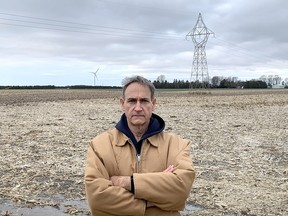Frustration is mounting for a community group trying to get Hydro One to take extra measures to ensure a proposed transmission line won’t harm North Kent-area water wells.

Frustration is mounting for a community group trying to get Hydro One to take extra measures to ensure a proposed transmission line won’t harm North Kent-area water wells.
Advertisement 2
Article content
“Getting Hydro One to fully understand and properly address the extreme environmental sensitivity of the water wells in Ward 4 (North Kent) is not going well,” said Kevin Jakubec, co-founder of Water Wells First.
Article content
The group wants the utility to do a groundwater baseline study before building the new 230-kilovolt St. Clair transmission line through an area that experienced well issues after the North Kent Wind project was constructed.
For the last three months, Jakubec said Hydro One has “stonewalled and deflected” calls for a groundwater baseline study to monitor wells in the St Clair transmission line project area.
The study would determine current water quality in the aquifer, and allow comparison between pre- and post-construction conditions to assess whether construction aggravated groundwater impacts, he added.
Advertisement 3
Article content
Water Wells first sounded the alarm in June 2016 that pile-driving vibrations during construction of the North Kent Wind farm’s 34 wind turbines would stir up Kettle Point black shale, known to contain heavy metals such as lead, arsenic and mercury, at the bottom of the aquifer. Sediment clogged many area homeowners’ wells after Korea’s Samsung Renewable Energy and its US partner, Pattern Energy, began construction.
Jakubec said a scientific advisory team, consisting of a hydrogeologist, bedrock geologist, well driller and academic researcher, met Hydro One officials last Friday to present a map of the most sensitive area along the proposed powerline route through North Kent, where the ground above the contact aquifer layer is less than 20 meters deep.
Advertisement 4
Article content
“This area is the most sensitive and must have a means of gathering information on the state of groundwater quality,” Jakubec said.
The scientific advisers said information could be gathered either by drilling monitoring wells or sampling existing wells in the identified area, he added.
Hydro One recently released a draft environmental study for the planned 230-kilovolt line linking a transformer station near Courtright to the Chatham area to help meet increased demand in Windsor-Essex and Chatham-Kent. It would pass through areas in Chatham-Kent, including North Kent. Construction on the line, expected to enter service in 2028, is set to begin in 2027.
“Hydro One takes the concerns about effects to groundwater in the North Kent area seriously and reflected the feedback we received in the design of our tower structures and associated foundations, which will remain between approximately 33 feet (10 meters) to 100 feet (30 meters ) above the aquifer layer, to ensure there is no interaction with the Kettle Point shale aquifer,” said Sonny Karunakaran, a Hydro One vice-president, in a statement.
Advertisement 5
Article content
“We will continue to work together with the community and consider all feedback as it comes in, to address concerns and find solutions throughout the planning, design, and construction of this project.”
Hydro One researched groundwater resources as part of its draft environmental study report, he said.
“Based on this information, as well as information collected from the ongoing geotechnical studies and our current engineering designs, we are able to confirm that the new transmission line structure foundations will remain significantly above the Kettle Point Shale contact aquifer,” he said.
Hydro One told Chatham-Kent council Nov. 27 it won’t use pile drivers to install project tower foundations. It will use screw (helical) batteries, which are simpler to install and cause minimal noise and vibration.
Advertisement 6
Article content
Jakubec said studies turned over to Hydro One Sept. 21 meeting raised concerns that St. Clair project towers will be substantially larger to handle the switch from 115-kilovolt to 230-kilovolt cables. He said the studies showed these towers need built-in vibration dampening.
“Helical batteries have less vibration than the hammer pile that the wind farms used in Ward 4, but they are not vibration-free,” Jakubec said. “They can cause disturbance” to water wells.
The bottom line, he said, is doing a groundwater baseline study is good environmental stewardship, engineering practice and community relations.
“If Hydro One refuses to implement a groundwater baseline in a known environmentally sensitive area, they cannot claim to be any of those and well owners in Ward 4 should prepare to meet the threat to their drinking groundwater source,” he said.
With files from Trevor Terfloth
Article content
